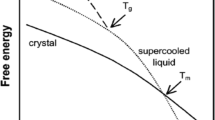Abstract
Several drug substances or excipients are hygroscopic. The uptake or loss of water of such substances is generally difficult to control during processing or storage of drug products. DSC instruments with sub-ambient temperature equipment allow the determination of the amount of freezable water by measuring the corresponding melting enthalpy.
The determination of freezable water adds valuable information complementary to TG analysis for understanding the processing and storage of raw materials and drug products. Several substances were tested as is, without treatment, after storage at 92% r.h. and after equilibration with water. The results of these experiments showed that it was possible to demonstrate defined hydrate formation, to determine the upper level of binding of water in amorphous substances and to confirm reversible hydrate formations demonstrated by temperature resolved X-ray diffraction.
Similar content being viewed by others
References
C. Ahlneck and G. Zografi, Int. J. Pharm., 62 (1990) 87.
K. Umprayn and R. W. Mendes, Drug Dev. Ind. Pharm., 13 (1987) 653.
S. R. Byrn, Solid State Chemistry of Drugs, Academic Press, 1982 p. 151.
R. K. Kankari and D. J. W. Grant, Thermochim. Acta, 234 (1994) 153.
M. Otsuka, N. Kaneniwa, K. Kawahami and O. Umezawa, J. Pharm. Pharmacol., 42 (1990) 606.
H. Ando, M. Ishii, M. Kayano and S. Wanatabe, Drug Dev. Ind. Pharm., 21 (1995) 2227.
M. Otsuka, Drug Dev. Ind. Pharm., 19 (1993) 541.
E. Laine, Acta Pharm. Fenn., 92 (1983) 243.
J. Elder, Thermochim. Acta, 234 (1994) 153.
K. R. Morris, A. W. Newman, D. E. Burgay, S. A. Ranadive, A. K. Singh, M. Szyper, S. A. Varia, H. G. Brittain and A. M. Serajuddin, Int. J. Pharm., 180 (1994) 195.
C. A. Oskasen and G. Zografi, Pharm. Res., 7 (1990) 654.
H. Zhu and D. I. W. Grant, Int. J. Pharm., 139 (1996) 33.
D. Giron and C. Goldronn, Analusis, 7 (1979) 109.
Sandoz Pharma, unpublished data.
D. Giron, M. Draghi, C. Goldbronn, S. Pfeffer and P. Piechon, J. Thermal Anal., 49 (1997) 907.
Author information
Authors and Affiliations
Rights and permissions
About this article
Cite this article
Giron, D., Goldbronn, C. Use of sub-ambient DSC to complement conventional DSC and TG. Journal of Thermal Analysis 49, 907–912 (1997). https://doi.org/10.1007/BF01996776
Issue Date:
DOI: https://doi.org/10.1007/BF01996776




